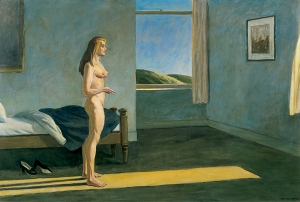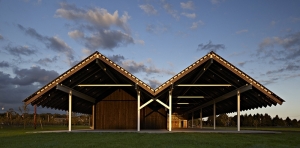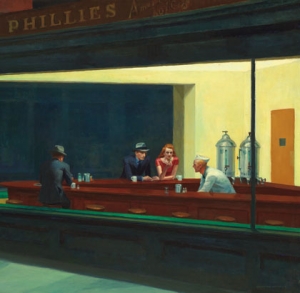|
Displaying items by tag: Realist

On December 22, American Legends: From Calder to O’Keeffe opened at the Whitney Museum of American Art in New York. The exhibition features works by defining artists of the first half of the twentieth century including Charles Burchfield (1893-1967), Alexander Calder (1898-1976), Stuart Davis (1892-1964), Arthur Dove (1880-1946), Marsden Hartley (1877-1943) , Edward Hopper (1882-1967), Georgia O’Keeffe (1887-1986), and Elie Nadelman (1880-1946).
Drawing from the Whitney’s impressive permanent collection, the yearlong show is organized into small-scale retrospectives for each artist and includes iconic and lesser-known works across a range of mediums. While, many of the works have not been on view in years, the show also includes some of the Whitney’s best-known holdings including Edward Hopper’s A Woman in the Sun (1961), Jacob Lawrence’s War Series 1946), and Georgia O’Keeffe’s Summer Days (1936).
Curated by Barbara Haskell, the exhibition will undergo a rotation in May 2013 so that other artists’ works can be installed. Including realist and modernist masterpieces, American Legends illustrates the dynamic and varied nature of American art during the early twentieth century.

Thomas Hart Benton’s (1889-1975) epic mural, America Today (1930-31) has found a new home at New York’s Metropolitan Museum of Art. A sweeping panorama of American life, the work once lined a boardroom at the International-Style New School for Social Research on West 12th Street, which was designed by the Austrian architect, Joseph Urban (1872-1933).
The 10-panel mural, which was Benton’s first major commission, ushered in a new approach to mural painting, turning to the reality of everyday life for inspiration. America Today portrays American life prior to the Great Depression and features the flappers, farmers, steel workers, and stock market moguls that are readily associated with the period. The mural remains Benton’s best-known work and a masterpiece of modern art.
Benton, an American realist painter, drew inspiration for the mural from his travels around the United States in the 1920s. A glimpse into both rural and urban life at the time, America Today portrays the wealthy and poor as well as the progressive and traditional ideals that defined the era. While Benton did not receive a fee for the commission, the work opened the door for future commissions and helped inspire the Works Progress Administration mural programs that were implemented in the late 1930s.
Bought by the insurance company, AXA Equitable, nearly 30 years ago, America Today was in storage before the decision to donate the work was made. However, the Met is currently without extra exhibition space and the mural won’t be on view until at least 2015 when the museum takes over the Whitney Museum of American Art’s Marcel Breuer building on Madison Avenue. The Whitney is headed to its own larger space in the meatpacking district. America Today is the first artwork that Met officials have confirmed for the Breuer building.

Earlier this month the Parrish Art Museum opened its new 34,400 square-foot building in Water Mill, NY to the public. Founded in 1898 by New York lawyer, Samuel Longstreth Parrish, to house his growing art collection, the museum had been a staple in Southampton, NY before moving to its new location that boasts seven sky-lit galleries and three times the exhibition space than that of the museum’s former home.
Now that the $26.2 million move is complete, the result of years of painstaking fund-raising, the Parrish hopes to become the area’s artistic epicenter. Designed by the Swiss architectural firm Herzog & Meuron in collaboration with the landscape architecture firm Reed Hilderbrand, the new Parrish building sits on 14 acres of land right off of the Montauk Highway. The building is meant to blend into the landscape and consists of connected, stretching barn-like structures that sit under a white corrugated metal roof. Large sections of glass allow the line between the natural and artificial worlds to blend.
An American art museum with about 2,600 paintings, sculptures, and works on paper in its collection, the Parrish pays extra attention to the art of the East End of Long Island. The former Southampton location was simply too small to exhibit many of the exemplary works from the museum’s permanent collection that spans from the 19th century to the present. Now, American Impressionist William Merritt Chase and the realist Fairfield Porter each have their own permanent galleries and there are three galleries just for temporary exhibitions.
Inaugurating the space is Malcolm Morley: Painting, Paper, Process, an exhibition devoted to the English-born artist known for exploring paper’s many artistic possibilities including watercolors, scale models, and freestanding sculptures. Approximately 50 works from the 1980s to present will be on view through January 13, 2013.
The Parrish’s new building also includes offices, a café, an expanded lobby, and a theater where film screenings, lectures, and performances will be held.

An expansive survey of works by the American realist artist, George Bellows, will open November 15 at the Metropolitan Museum of Art in New York City. The exhibition features 120 works including the paintings of boxing matches and gritty New York tenements that Bellows is best known for. The artist also painted cityscapes, seascapes, war scenes, portraits, and made illustrations and lithographs over the course of a varied career that was cut short when Bellows passed away at 42.
Born and raised in Columbus, Ohio, Bellows moved to New York City in 1904 to study with the influential artist and teacher, Robert Henri, and soon became the youngest member of the Ashcan School. Dedicated to chronicling the realities of day-to-day life, Bellows made a name as the boldest of the Ashcan artists. The Met acquired Bellows’ Up the Hudson (1808), the institution’s first Ashcan painting, in 1911.
Organized by the National Gallery of Art in Washington, D.C. in association with the Met and London’s Royal Academy of Art, the retrospective is the most comprehensive presentation of Bellows work in nearly fifty years. The exhibition will be on view through February 18, 2013.

Best known for his paintings of stark diner scenes, snapshots of city life, and quiet portraits of the American landscape, there is much more to Edward Hopper’s (1882–1967) oeuvre than one might think. Referred to as a romantic, a realist, a symbolist, and even a formalist, the exhibition, Paintings by Edward Hopper (1882–1967) currently on view at the Grand Palais, Galeries Nationales in Paris aims to explore each facet of Hopper’s artistic identity.
Divided chronologically into two main parts, the first section of the exhibition covers Hopper’s early work from 1900 to 1924. During this time Hopper studied at the New York School of Art under Robert Henri, the founder of the Ashcan School of realism. Hopper also spent nearly a year in Paris in 1906, followed by shorter stays in 1909 and 1910.
The first part of the exhibition sets out to compare Hopper’s early work to that of his contemporaries as well as to the art he saw while in Paris. While in Europe, Hopper was influenced by such things as Degas’ original angles to Vermeer’s use of light. He was also moved by the soft, harmonious nature of Impressionism, which is reflected in his work from the time. This work is in sharp contrast to the almost gritty realism Hopper favored back in the United States.
1924 marked a turning point in Hopper’s career. After successful exhibitions of his watercolors of neo-Victorian houses in Gloucester, Massachusetts at the Brooklyn Museum and the Franck Rehn’s Gallery (New York), Hopper enjoyed commercial success and was able to fully devote his life to his art. Hopper’s watercolors mark the second section of the Grand Palais exhibition and feature the iconic paintings most people associate with the artist.
Curated by Didier Ottinger, assistant director of the MNAM – Center Pompidou, the exhibition of Hopper’s work will be on view through January 28, 2013.
When painter Philip Pearlstein moved to Manhattan in 1949, he and his college pal Andy Warhol subletted an dingy eighth-floor walk-up on St. Marks Place and Avenue A.
“The bathtub was in the kitchen and it was usually full of roaches, incredible roaches,” Mr. Pearlstein once said of the apartment. Nor did their lot improve when they relocated to a West 23rd Street loft a few months later.

Robert Vickrey, a painter whose often unnerving depictions of shadow-streaked streets populated by nuns, clowns or children at play made him a leading figure of the magic realism school, died on Sunday at his home in Naples, Fla. He was 84.
The death was confirmed by his son, Scott.
Mr. Vickrey, who mastered the Renaissance technique of egg tempera painting as a student at Yale, used his consummate skill to create, in his early work, hyper-real scenes suffused by an atmosphere of dread or impending disaster. He was an avant-garde filmmaker on the side, with a deep knowledge of expressionism and film noir, whose shadows, angles and distortions he introduced into his paintings.
In the 1950s and ’60s Mr. Vickrey was a highly visible artist. He was included in no fewer than nine of the Whitney Museum’s annual exhibitions showcasing contemporary art. He was also commissioned to paint dozens of portraits for the cover of Time, notably a portrait from life of the Rev. Dr. Martin Luther King Jr. for the magazine’s Man of the Year issue in 1964.
As his style of painting fell out of favor, Mr. Vickrey was relegated to the margins of the art world. Critics did not always respond kindly to the more upbeat tone of his later painting, moreover, which seemed closer to Andrew Wyeth and Norman Rockwell than his chilling early work.
In the 1980s, a reassessment of magic realism, and of overlooked artists like Paul Cadmus, Jared French and George Tooker (who died on March 27), led to renewed interest in Mr. Vickery’s work. He was the subject of a retrospective exhibition at the Museum of Art, Science and Industry in Bridgeport, Conn., in 1982, and of a biography by Philip Eliasoph, “Robert Vickrey: The Magic of Realism” (Hudson Hills, 2008).
|
|
|
|
|